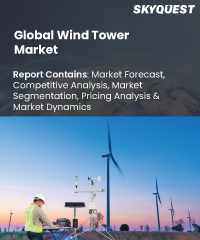USD 24.30 billion

Global Wind Tower Market Size, Share, Growth Analysis, By Type(steel towers, concrete towers), By application(Off-Shore and On-Shore) - Industry Forecast 2024-2031
Report ID:
SQMIG55E2008 |
Region:
Global |
Published Date: April, 2024
Pages:
182
|
Tables:
61 |
Figures:
75
Global Wind Tower Market Insights
Wind Tower Market size was valued at USD 24.30 billion in 2022 and is poised to grow from USD 26.15 billion in 2023 to USD 46.98 billion by 2031, growing at a CAGR of 7.60% during the forecast period (2024-2031).
A wind tower is a tall structure with the nacelle and wind turbine on top. The wind tower's length is primarily determined by the turbine's energy output capability and the size of its blades. Wind turbines with massive blades that are not raised sufficiently risk colliding with objects on the ground. As a result, selecting the proper height for a wind tower is critical to keeping the wind turbine's long blades clear of the ground and other objects.
The cost of wind towers is determined by the weight of the nacelle and turbine. A wind tower's material, gauge, and weight, in turn, have a direct impact on its strength and stability. The application is the most important factor influencing wind tower design. As a result, onshore wind towers differ significantly from those designed for offshore use.
US Wind Tower Market is poised to grow at a sustainable CAGR for the next forecast year.
Market snapshot - 2024-2031
Global Market Size
Largest Segment
On-Shore
Fastest Growth
On-Shore
Growth Rate
7.60% CAGR
To get more reports on the above market click here to Buy The Report
Global Wind Tower Market Segmental Analysis
wind tower market is segmented based on the type application and region. Based on type, the market is segmented into steel towers, concrete towers, and hybrid towers. Based on application, the market is segmented into Off-Shore and On-Shore. Based on Region it is categorized into North America, Europe, Asia-Pacific, Latin America, and MEA.
Analysis by Type
Based on type, The concrete towers segment dominated the wind tower market in 2021, and the segment is expected to grow at a rapid pace during the forecast period. These towers are strong, require little transportation, and the materials required to construct them are commonly available locally. Large turbines are also heavier, require larger rotors, and are taller. Because of their high strength, concrete wind towers are more cost-effective than tubular steel towers for these types of turbines.
Analysis by Application
Based on application, In 2021, the On-Shore segment held the largest market share, accounting for 67% of the total. The onshore segment emits less carbon and has a more cost-effective cost structure than the other segments. More than 59 GW of new onshore wind generation capacity will be installed globally by 2020.
To get detailed analysis on other segments, Request For Free Sample Report
Global Wind Tower Market Regional Insights
Asia Pacific is expected to lead the global market Over the forecast period. The Asia Pacific region leads in onshore wind installation. Power demand continues to rise in countries such as China, India, and Australia as a result of rapid industrialization and urbanisation. China has the most wind capacity, with 1,164 MW of new offshore wind power installations.
Europe is the world's second-largest market for wind turbines. It is also the most advanced region for offshore wind installation. The rapid expansion of wind farms and favourable regulations are the primary factors driving the market's growth in Europe. The EU Renewable Energy Directive lays out the strategy for promoting and producing sustainable energy sources across the country. This directive mandates a 20% renewable adoption rate in the overall energy mix. Such factors contribute to the market's continued expansion.
- Largest
- Fastest
To know more about the market opportunities by region and country, click here to
Buy The Complete Report
Global Wind Tower Market Dynamics
Drivers
Government Regulations to Bring Lucrative Growth Opportunities
- Globally, increased environmental protection regulations force the power generation industry to shift to cleaner and more environmentally friendly energy resources. Major economies around the world are focusing heavily on developing renewable energy power generation in order to reduce their reliance on conventional power generation via fossil fuels. Wind energy is a major renewable energy source that has the potential to address many of the world's challenges. Wind power installation increased to 651 GW in 2019, with the world installing 60.4 GW of new wind power projects. The Asia Pacific region accounted for 50.7% of all new installations, with 30.6 GW installed. As a result, such a massive annual increase in wind power capacity is undoubtedly boosting this market globally.
- The renewables investment track record over the last few years demonstrates that the focus on reducing global dependence on coal and other fossil fuels is well underway. As a result, several new wind power energy projects are being established around the world, and they will begin contributing to the global energy mix consistently in the coming years. The important role played by government initiatives and policies is one of the primary drivers of market growth. Feed-in tariffs, tax credits, net metering, and capital subsidies are the major energy policies explicitly geared towards wind in many countries, including the United States, China, Japan, and the European Union.
Restraints
Price Fluctuation to Hinder Market Growth
- Steel is a common raw material used in the construction of wind turbines. Steel price fluctuations impede the growth of the wind tower market. Steel is the most widely traded metal in the world, so price fluctuations harm a variety of end-use industries. Wind turbines are made from such steel sheets all over the world. Thus, price fluctuations affect production costs, influencing global market growth.
Request Free Customization of this report to help us to meet your business objectives.
Global Wind Tower Market Competitive Landscape
wind tower market is highly competitive and somewhat fragmented. To maintain a competitive edge, the major industry participants are continually implementing various growth strategies. Innovations, mergers, and acquisitions, collaborations and partnerships are adopted by these players to thrive in the competitive market. In order to provide industries with the most effective and economical solutions, the major market players are also continually concentrating on R&D. Key players are focusing on increasing production capacity by introducing new plants or expanding existing ones. The strong product portfolio and remarkable distribution network of major companies in developed and emerging markets have consolidated the global market. However, the limited number of domestic players entering the global market will face significant entry barriers. This increases the market's competitiveness in the future. Companies are increasing their production capacity by establishing new plants or expanding existing ones. The Nordex Group recently opened a plant for the production of concrete towers in the northern Brazilian state of Brazil Paul. The plant will manufacture the 65 towers needed for the "Lagoa do Barro" wind farm. Companies are also focusing on new contracts. For example, in April 2020, Broadwind Energy, a US wind industry supplier, received a USD 19 million wind tower order from a wind turbine manufacturer. The tower sections are expected to be delivered by early 2021, according to the company.
Top Player's Company Profiles
- CS Wind Corporation
- Shanghai Taisheng Wind Power Equipment Co., Ltd.
- Trinity Structural Towers, Inc.
- Vestas Wind Systems A/S
- General Electric Company
- Enercon GmbH
- Suzlon Energy Limited
- Siemens Gamesa Renewable Energy, S.A.
- Goldwind Science & Technology Co., Ltd.
- Ming Yang Smart Energy Group Limited
- Nordex SE
- Senvion S.A.
- Samsung Heavy Industries Co., Ltd.
- Envision Energy Limited
- China Ming Yang Wind Power Group Limited
- Dongkuk S&C
- Siemens AG
- Zhejiang Guoxing Wind Power Technology Co., Ltd.
- Marmen Inc.
- Wuxi Baotong Steel Co., Ltd.
Recent Developments
- In September 2022, Inox Wind, India's leading wind energy solutions provider, announced the commissioning of India's first 3.3 MW wind turbine in Village Ranparda, Taluka Jasdan, District Rajkot in Gujarat by Chief Minister of Gujarat, Bhupendrabhai Patel. The 3.3 MW wind turbine, developed with AMSC as technology partner, features a 100 m tubular tower and 146 m rotor blades -one of the largest in its class.
- In September 2022, Vestas and tower specialist Max Bögl launched a hybrid tower with a hub height of 199 metres – which they say is currently the world's tallest onshore tower for wind turbines.
Global Wind Tower Key Market Trends
- Global population growth, a thriving industrial sector, and increased infrastructure development activities are all contributing to a significant increase in demand for electricity. The demand for energy is increasing as countries develop and their standard of living improves. As demand for electricity grows, regions around the world are expanding their power generation capacity by building new plants or expanding the capacity of existing ones. Companies are more inclined to use renewable energy sources for power generation, particularly solar energy and wind power, due to stringent government regulations governing greenhouse gas emissions.
Global Wind Tower Market SkyQuest Analysis
SkyQuest’s ABIRAW (Advanced Business Intelligence, Research & Analysis Wing) is our Business Information Services team that Collects, Collates, Co-relates, and Analyses the Data collected utilizing Primary Exploratory Research backed by the robust Secondary Desk research.
According to our wind tower market analysis, in terms of types, the concrete tower segment boosts the market share. This is because of its high strength and in terms of application, the On-Shore segment enhances the market value owing to cost effectiveness. Moreover, increasing Investment in Wind Energy and Supportive Government Initiatives and Policies driving the market expansion. Whereas, Fluctuating Prices of Steel can be a restraining factor to the wind tower market growth.
| Report Metric | Details |
|---|---|
| Market size value in 2022 | USD 24.30 billion |
| Market size value in 2031 | USD 46.98 billion |
| Growth Rate | 7.60% |
| Base year | 2023 |
| Forecast period | 2024-2031 |
| Forecast Unit (Value) | USD Billion |
| Segments covered |
|
| Regions covered | North America (US, Canada), Europe (Germany, France, United Kingdom, Italy, Spain, Rest of Europe), Asia Pacific (China, India, Japan, Rest of Asia-Pacific), Latin America (Brazil, Rest of Latin America), Middle East & Africa (South Africa, GCC Countries, Rest of MEA) |
| Companies covered |
|
| Customization scope | Free report customization with purchase. Customization includes:-
|
To get a free trial access to our platform which is a one stop solution for all your data requirements for quicker decision making. This platform allows you to compare markets, competitors who are prominent in the market, and mega trends that are influencing the dynamics in the market. Also, get access to detailed SkyQuest exclusive matrix.
Buy The Complete Report to read the analyzed strategies adopted by the top vendors either to retain or gain market share
Table Of Content
Executive Summary
Market overview
- Exhibit: Executive Summary – Chart on Market Overview
- Exhibit: Executive Summary – Data Table on Market Overview
- Exhibit: Executive Summary – Chart on Global Wind Tower Market Characteristics
- Exhibit: Executive Summary – Chart on Market by Geography
- Exhibit: Executive Summary – Chart on Market Segmentation
- Exhibit: Executive Summary – Chart on Incremental Growth
- Exhibit: Executive Summary – Data Table on Incremental Growth
- Exhibit: Executive Summary – Chart on Vendor Market Positioning
Parent Market Analysis
Market overview
Market size
- Market Dynamics
- Exhibit: Impact analysis of DROC, 2021
- Drivers
- Opportunities
- Restraints
- Challenges
- Exhibit: Impact analysis of DROC, 2021
- SWOT Analysis
KEY MARKET INSIGHTS
- Technology Analysis
- (Exhibit: Data Table: Name of technology and details)
- Pricing Analysis
- (Exhibit: Data Table: Name of technology and pricing details)
- Supply Chain Analysis
- (Exhibit: Detailed Supply Chain Presentation)
- Value Chain Analysis
- (Exhibit: Detailed Value Chain Presentation)
- Ecosystem Of the Market
- Exhibit: Parent Market Ecosystem Market Analysis
- Exhibit: Market Characteristics of Parent Market
- IP Analysis
- (Exhibit: Data Table: Name of product/technology, patents filed, inventor/company name, acquiring firm)
- Trade Analysis
- (Exhibit: Data Table: Import and Export data details)
- Startup Analysis
- (Exhibit: Data Table: Emerging startups details)
- Raw Material Analysis
- (Exhibit: Data Table: Mapping of key raw materials)
- Innovation Matrix
- (Exhibit: Positioning Matrix: Mapping of new and existing technologies)
- Pipeline product Analysis
- (Exhibit: Data Table: Name of companies and pipeline products, regional mapping)
- Macroeconomic Indicators
COVID IMPACT
- Introduction
- Impact On Economy—scenario Assessment
- Exhibit: Data on GDP - Year-over-year growth 2016-2022 (%)
- Revised Market Size
- Exhibit: Data Table on Global Wind Tower Market size and forecast 2021-2027 ($ million)
- Impact Of COVID On Key Segments
- Exhibit: Data Table on Segment Market size and forecast 2021-2027 ($ million)
- COVID Strategies By Company
- Exhibit: Analysis on key strategies adopted by companies
MARKET DYNAMICS & OUTLOOK
- Market Dynamics
- Exhibit: Impact analysis of DROC, 2021
- Drivers
- Opportunities
- Restraints
- Challenges
- Exhibit: Impact analysis of DROC, 2021
- Regulatory Landscape
- Exhibit: Data Table on regulation from different region
- SWOT Analysis
- Porters Analysis
- Competitive rivalry
- Exhibit: Competitive rivalry Impact of key factors, 2021
- Threat of substitute products
- Exhibit: Threat of Substitute Products Impact of key factors, 2021
- Bargaining power of buyers
- Exhibit: buyers bargaining power Impact of key factors, 2021
- Threat of new entrants
- Exhibit: Threat of new entrants Impact of key factors, 2021
- Bargaining power of suppliers
- Exhibit: Threat of suppliers bargaining power Impact of key factors, 2021
- Competitive rivalry
- Skyquest special insights on future disruptions
- Political Impact
- Economic impact
- Social Impact
- Technical Impact
- Environmental Impact
- Legal Impact
Market Size by Region
- Chart on Market share by geography 2021-2027 (%)
- Data Table on Market share by geography 2021-2027(%)
- North America
- Chart on Market share by country 2021-2027 (%)
- Data Table on Market share by country 2021-2027(%)
- USA
- Exhibit: Chart on Market share 2021-2027 (%)
- Exhibit: Market size and forecast 2021-2027 ($ million)
- Canada
- Exhibit: Chart on Market share 2021-2027 (%)
- Exhibit: Market size and forecast 2021-2027 ($ million)
- Europe
- Chart on Market share by country 2021-2027 (%)
- Data Table on Market share by country 2021-2027(%)
- Germany
- Exhibit: Chart on Market share 2021-2027 (%)
- Exhibit: Market size and forecast 2021-2027 ($ million)
- Spain
- Exhibit: Chart on Market share 2021-2027 (%)
- Exhibit: Market size and forecast 2021-2027 ($ million)
- France
- Exhibit: Chart on Market share 2021-2027 (%)
- Exhibit: Market size and forecast 2021-2027 ($ million)
- UK
- Exhibit: Chart on Market share 2021-2027 (%)
- Exhibit: Market size and forecast 2021-2027 ($ million)
- Rest of Europe
- Exhibit: Chart on Market share 2021-2027 (%)
- Exhibit: Market size and forecast 2021-2027 ($ million)
- Asia Pacific
- Chart on Market share by country 2021-2027 (%)
- Data Table on Market share by country 2021-2027(%)
- China
- Exhibit: Chart on Market share 2021-2027 (%)
- Exhibit: Market size and forecast 2021-2027 ($ million)
- India
- Exhibit: Chart on Market share 2021-2027 (%)
- Exhibit: Market size and forecast 2021-2027 ($ million)
- Japan
- Exhibit: Chart on Market share 2021-2027 (%)
- Exhibit: Market size and forecast 2021-2027 ($ million)
- South Korea
- Exhibit: Chart on Market share 2021-2027 (%)
- Exhibit: Market size and forecast 2021-2027 ($ million)
- Rest of Asia Pacific
- Exhibit: Chart on Market share 2021-2027 (%)
- Exhibit: Market size and forecast 2021-2027 ($ million)
- Latin America
- Chart on Market share by country 2021-2027 (%)
- Data Table on Market share by country 2021-2027(%)
- Brazil
- Exhibit: Chart on Market share 2021-2027 (%)
- Exhibit: Market size and forecast 2021-2027 ($ million)
- Rest of South America
- Exhibit: Chart on Market share 2021-2027 (%)
- Exhibit: Market size and forecast 2021-2027 ($ million)
- Middle East & Africa (MEA)
- Chart on Market share by country 2021-2027 (%)
- Data Table on Market share by country 2021-2027(%)
- GCC Countries
- Exhibit: Chart on Market share 2021-2027 (%)
- Exhibit: Market size and forecast 2021-2027 ($ million)
- South Africa
- Exhibit: Chart on Market share 2021-2027 (%)
- Exhibit: Market size and forecast 2021-2027 ($ million)
- Rest of MEA
- Exhibit: Chart on Market share 2021-2027 (%)
- Exhibit: Market size and forecast 2021-2027 ($ million)
KEY COMPANY PROFILES
- Competitive Landscape
- Total number of companies covered
- Exhibit: companies covered in the report, 2021
- Top companies market positioning
- Exhibit: company positioning matrix, 2021
- Top companies market Share
- Exhibit: Pie chart analysis on company market share, 2021(%)
- Total number of companies covered
Methodology
For the Global Wind Tower Market, our research methodology involved a mixture of primary and secondary data sources. Key steps involved in the research process are listed below:
1. Information Procurement: This stage involved the procurement of Market data or related information via primary and secondary sources. The various secondary sources used included various company websites, annual reports, trade databases, and paid databases such as Hoover's, Bloomberg Business, Factiva, and Avention. Our team did 45 primary interactions Globally which included several stakeholders such as manufacturers, customers, key opinion leaders, etc. Overall, information procurement was one of the most extensive stages in our research process.
2. Information Analysis: This step involved triangulation of data through bottom-up and top-down approaches to estimate and validate the total size and future estimate of the Global Wind Tower Market.
3. Report Formulation: The final step entailed the placement of data points in appropriate Market spaces in an attempt to deduce viable conclusions.
4. Validation & Publishing: Validation is the most important step in the process. Validation & re-validation via an intricately designed process helped us finalize data points to be used for final calculations. The final Market estimates and forecasts were then aligned and sent to our panel of industry experts for validation of data. Once the validation was done the report was sent to our Quality Assurance team to ensure adherence to style guides, consistency & design.
Analyst Support
Customization Options
With the given market data, our dedicated team of analysts can offer you the following customization options are available for the Global Wind Tower Market:
Product Analysis: Product matrix, which offers a detailed comparison of the product portfolio of companies.
Regional Analysis: Further analysis of the Global Wind Tower Market for additional countries.
Competitive Analysis: Detailed analysis and profiling of additional Market players & comparative analysis of competitive products.
Go to Market Strategy: Find the high-growth channels to invest your marketing efforts and increase your customer base.
Innovation Mapping: Identify racial solutions and innovation, connected to deep ecosystems of innovators, start-ups, academics, and strategic partners.
Category Intelligence: Customized intelligence that is relevant to their supply Markets will enable them to make smarter sourcing decisions and improve their category management.
Public Company Transcript Analysis: To improve the investment performance by generating new alpha and making better-informed decisions.
Social Media Listening: To analyze the conversations and trends happening not just around your brand, but around your industry as a whole, and use those insights to make better Marketing decisions.
Global Wind Tower Market Report Snapshots
Want to customize this report?
Our industry expert will work with you to provide you with customized data in a short amount of time.
REQUEST FREE CUSTOMIZATION



 USA (+1) 351-333-4748
USA (+1) 351-333-4748
